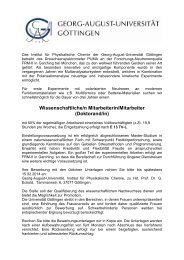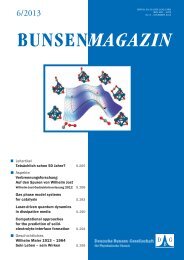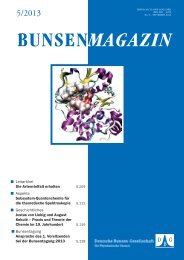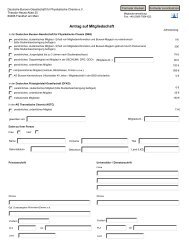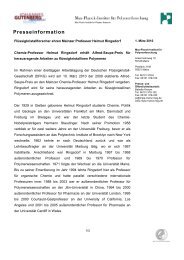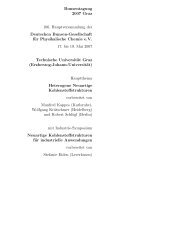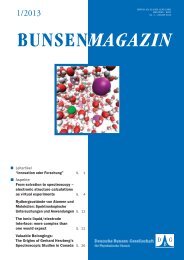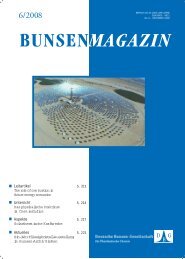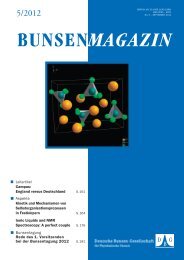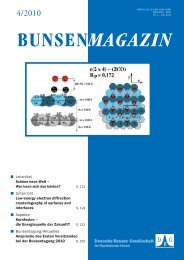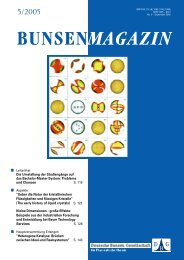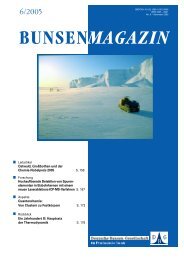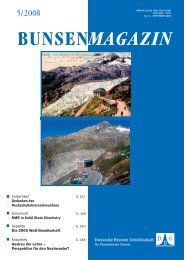BUNSENMAGAZIN - Deutsche Bunsengesellschaft für ...
BUNSENMAGAZIN - Deutsche Bunsengesellschaft für ...
BUNSENMAGAZIN - Deutsche Bunsengesellschaft für ...
Erfolgreiche ePaper selbst erstellen
Machen Sie aus Ihren PDF Publikationen ein blätterbares Flipbook mit unserer einzigartigen Google optimierten e-Paper Software.
UNTERRICHT<br />
1 H- 1 H dipolar couplings by means of selective radiofrequency<br />
pulses is achieved by “MAS in spin space”. 18,20 In high magnetic<br />
fi elds, a regular MAS NMR probe is often suffi cient while in<br />
lower magnetic fi elds (£ 400 MHz, 9.4 T) specially optimized<br />
MAS probes are necessary limiting widespread application of<br />
these combined line-narrowing techniques. Besides, reduction<br />
(or removal) of the homonuclear dipolar couplings also scales<br />
the chemical shift and hence requires careful calibration.<br />
Figure 8: (left) Schematic representation of the LEE-GOLDBURG irradiation:<br />
the combination of a certain radiofrequency field with an offset frequency<br />
produces an effective radiofrequency field that is aligned at the magic angle.<br />
(right) 1 H MAS NMR spectra at 850.1 MHz of α-glycine at 30 kHz MAS<br />
(bottom) and wPMLG at 15 kHz MAS (top). Note the significant narrowing of<br />
the line-shapes. 37<br />
2.4 HETERONUCLEAR MULTI-QUANTUM NMR<br />
Double-quantum or more generalized multi-quantum NMR is<br />
also possible for heteronuclear spin pairs such as 13 C- 1 H or<br />
15 N- 1 H, and offers signifi cant advantages for obtaining more<br />
specifi c distance constraints while exploiting the much higher<br />
site selectivity of 13 C and 15 N chemical shifts. Once specifi c<br />
spin pairs of interest are identifi ed, precise measurement<br />
of their corresponding dipole-dipole couplings via spinning<br />
sidebands, similar to the 1 H- 1 H homonuclear case mentioned<br />
above, provides an effi cient way to study molecular dynamics<br />
in analogy to 2 H-NMR experiments, 15 but without the need of<br />
elaborate isotope labeling. Rotational-Echo Double-Resonance<br />
(REDOR) 29,42 currently is most popular for determining heteronuclear<br />
dipole-dipole couplings in solids. It comprises a particularly<br />
simple but versatile approach of recoupling, i.e. the<br />
application of equally spaced p-pulses twice per rotor period<br />
on one of the isotopes. If, however, one of the considered isotopes<br />
has a rather low natural abundance (like e.g. 13 C or 15 N),<br />
isotope-enriched samples are often required for the sake of<br />
an appropriate signal-to-noise ratio and NMR measurement<br />
time requirements. Though this can be tedious in some cases,<br />
isotope labeling of specifi c sites (e.g. introduction of 13 C spin<br />
pairs) offers the advantage of background suppression (e.g.<br />
unwanted signals due to natural abundance 13 C spins), when<br />
the initial magnetization is prepared by a double-quantum fi lter,<br />
as recently exploited in the study of DNA packaging in bacteriophages<br />
(DQF-REDOR). 43<br />
In fact, the REDOR technique can be seen as the basis of many<br />
more sophisticated ways of reintroducing homo- and heteronuclear<br />
dipole-dipole as well as anisotropic chemical shift interactions<br />
under MAS. 36,44,45 Pictorially speaking the mechanical<br />
rotation by MAS in real space is partially offset by counter<br />
rotations in spin space. REDOR can be used in two alternative<br />
ways: on one hand, the signal intensity can be followed<br />
as a function of the dipolar recoupling time thereby producing<br />
66<br />
BUNSEN-MAGAZIN · 11. JAHRGANG · 2/2009<br />
build-up curves, which are also termed dephasing curves. This<br />
approach has been described in detail in a previous issue of<br />
this series 19 and is not repeated here. On the other hand, we<br />
can utilize the rotor encoded signal that evolves when an incremented<br />
time period t 1 is inserted between two REDOR-type<br />
pulse trains 46 (cf. fi gure 9).<br />
Figure 9. Basic REDOR 29 pulse sequence (top) and the rotor-encoded version<br />
(RE-REDOR) 46 (bottom).<br />
The fi rst recoupling period creates a signal that corresponds<br />
to the conventional REDOR sequence. Similar to the DQ case<br />
detailed above, when using increments in t 1 of less than a rotor<br />
period, rotor encoding yields characteristic MAS sideband patterns<br />
comprised of (ideally) only odd sidebands. In fact, the frequency<br />
distribution of the sideband pattern (that is observing<br />
suffi cient intensity of sidebands of nth order) critically depends<br />
on the underlying heteronuclear dipolar coupling D ij and can be<br />
adjusted by setting appropriate recoupling times (cf. fi gure 7).<br />
In conventional REDOR build-up curves, however, perturbing<br />
multi-spin effects damp out the oscillatory behaviour of the polarization<br />
transfer curve so that typically only the initial slope<br />
of the curve is considered. 19 Such multi-spin effects appear as<br />
additional even sidebands in RE-REDOR curves and are thus<br />
separated from the spin pair signal rendering distance constraints<br />
obtained from RE-REDOR curves more accurate. 47<br />
Figure 10: Comparison between REDOR build-up curve and RE-REDOR sideband<br />
pattern. Note that positions (ii) and (iii) are rather difficult to account for in the<br />
build-up curve but can be exploited in the respective sideband pattern. 46<br />
When applied under fast MAS in order to effi ciently reduce<br />
the otherwise perturbing homonuclear dipole-dipole coupling,<br />
REDOR can be also combined with multiple-quantum spec-



